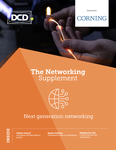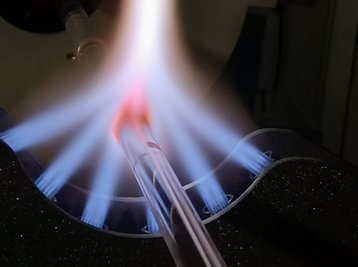Advancements in fiber cabling have been few and far between in recent years.
The cables being laid at scale by the telecommunications industry today are pretty similar to those that were being fed through holes in the ground decades ago.
Fiber is, of course, essential to how networks are connected and is especially important for connecting data centers.
But traditional fiber isn’t the only optical option on the market. There is also hollow core fiber (HCF), which some believe could herald a long-awaited paradigm shift.
Hollow core fiber represents the next revolution in optical networking, offering unprecedented speeds and lower latency that traditional fiber simply cannot match,” says Dr. Winston Schoenfeld, vice president for research and innovation at the University of Central Florida.
What is hollow core fiber?
Hollow core fiber’s name offers a clue as to how it differs from regular fiber. Rather than featuring a glass core, it has a hollow space in the middle through which light is transmitted.
This technology isn’t new, having been around for more than 20 years, while the theory behind it can trace its roots back to the 19th century.
In 1897, English physicist Lord Rayleigh studied the transmission of electromagnetic waves in hollow dielectric structures. Although this wasn’t HCF as such, the concept paved the way for the cables being used by digital infrastructure providers today.
Inside the hollow, HCF features an air-filled center channel that is surrounded by a ring of tubes, akin to a honeycomb pattern. The design allows for higher capacity with minimized chromatic dispersion. The only glass involved is on the outside structure of the cable itself.
“With single-mode fiber, you’re using glass to reflect glass and there are problems with that,” says Andrew Lord, optics and quantum R&D lead at BT. “It’s very low loss, but the glass is not completely negligible. It still has imperfections and impurities, so it still causes attenuation of the signal.”
Attenuation refers to a reduction in the signal that can pass through the fiber.
This means, Lord says, that alternatives are required, because “you want to build networks with absolutely no loss, no attenuation at all.”
Lord makes the point that the fiber being put into the ground now is still very similar to the single-mode fiber back from the 1980s. “It’s improved, but it’s not a radical, disruptive new fiber,” he says.
“Hollow core is disruptive because there’s nothing in the middle, and instantly that tells you, if there’s no glass there, maybe I can benefit around attenuation or loss. If there’s no glass, there are no impurities. So you would hope to be able to make a fiber that could go further, for longer distances
Faster and further
HCF also offers a speed advantage, and could be a significantly quicker alternative to traditional silica-based fiber cabling.
“With hollow core fiber, light travels 50 percent faster,” Jason Eichenholz, Relativity Networks’ founder and CEO tells DCD.
Relativity Networks specializes in providing fiber, including hollow-core fiber, for its clients and recently raised $4.6 million in pre-seed funding as part of its HCF development plans.
“Instead of using a total internal reflection in the glass, you use tubes, and these tubes keep the electric field constrained inside that air core,” he says, noting that this can provide 33 percent lower latency.
The company, founded in 2023, has partnered with the University of Central Florida (UCF) to develop the technology. Relativity says it’s commercializing patent-pending HCF technology originally developed by co-founder Professor Rodrigo Amezcua at CREOL, the College of Optics and Photonics at the University of Central Florida.
Relativity claims that the latency constraints of traditional fiber optic cables mean interlinked data centers can only be a maximum of 60 kilometers (37 miles) apart. However, the company says its HCF technology can extend this to 90 kilometers (56 miles), something which could be a boon for operators in the era of massive multi-site AI data center deployments.
Eichenholz has built a career in photonics and optics. Before setting up Relativity Networks, he co-founded Luminar Technologies, a company that develops vision-based lidar and machine perception technologies, primarily for self-driving cars. It provided lidar technology for Volvo’s self-driving cars, and went public in a $3.4 billion SPAC merger five years ago.
The listing of Luminar presumably made Eichenholz a few dollars, but the potential of HCF has tempted him back to work.
“I know a great market when I see one,” he laughs. “I was essentially retired, but this opportunity came along with hollow core fiber right as AI was beginning to take off but struggling to grow.
“We can be a major player in supporting that growth.”
Powering the data center
The data center industry’s challenges around obtaining the power it needs are well-documented and show no signs of going away. In a forecast last year, Gartner predicted that power shortages will restrict 40 percent of AI data centers by 2027.
According to Eichenholz, HCF can allow hyperscalers to build data centers where power is available, safe in the knowledge that transferring data to and from their facilities will not be a problem. This could open up a 2.5x larger geographic area for data center selection, he says.
“Currently, new data centers can’t be built fast enough to satisfy the rapidly expanding AI-driven economy, and the lack of available power is an existential threat to fueling that growth,” Eichenholz says.
“By moving data faster with lower latency at nearly the speed of light, we are providing the industry new geographic optionality to address the energy-intensive data needs of today’s AI-driven digital economy.”
Relativity has so far connected two data center sites with its HCF over live traffic, though Eichenholz wasn’t able to name the data center companies it has worked with or where they were located.
Microsoft’s HCF play
Hyperscalers have taken note of HCF as well, with Microsoft snapping up UK-based HCF startup Lumenisity Limited back in 2022.
Specializing in manufacturing HCF, Lumenisity was established five years earlier as a spin-off from the Optoelectronics Research Centre (ORC) at the University of Southampton to commercialize its HCF technologies.
The company has previously conducted trials with BT and Mavenir Telecom, and has a 40,000 sq ft (3,715 sqm) HCF manufacturing facility in Romsey, UK.
At the time of the acquisition, Microsoft noted the deal would “further optimize its global cloud infrastructure” and serve the company’s cloud platform and services customers with strict latency and security requirements.
Last year, the company attained the lowest optical fiber loss ever recorded at a 1550nm wavelength, even lower than pure silica core single mode fiber (SMF).
Colin Wallace, general manager of cloud network engineering, Azure Fiber, says that HCF can significantly improve the volume of data that’s transmitted over fiber. He adds that latency is limited with SMF.
“If you have a data center, you build it up, it gets full, and then you look for an expansion for that region with the latency, there are limits that are in place to expand the region,” he explains.
“Where you typically have a radius of about 80 km out from the original data center to go and look for space and power to grow your region. If you use hollow core fiber, then that becomes 120 kilometers.”
He explains that with SMF, the amount of power that can be put into the fiber is limited, as attempting to distribute too much into the glass fiber will impact negatively on how it can handle traffic.
“There’s a sweet spot for your launch power within the glass that limits the amount of power you can put into the fiber before it actually performs worse,” says Wallace.
Instead, with HCF, Wallace notes the only constraints around power are safety-related.
“You could potentially go for very long distances with high power launch and a very low loss fiber,” he explains. “The potential is there to go very, very long distances without having to have an amplifier.”
He says this could even be put into subsea cables at some point, using an unrepeated version of the subsea cable, which he says would be cheaper as well.
As for use cases, Microsoft has previously stated that healthcare, financial services, manufacturing, retail, and government sectors could benefit from HCF.
High-frequency trading on the stock market has also been tipped as a solid use case to demonstrate HCF’s capabilities. Every millisecond counts in the trading world, so quicker transfer speeds and lower latency could be a game-changer.
“HCF is a very serious premium product that people are charging a lot of money for,” Lord says. “They’re not making much of it. It’s aiming at the high-end markets like financial trading, where people are prepared to pay for this.”
The growth of AI is also facilitating the need for HCF, with startups like Relativity Networks trying to grab a slice of the pie alongside the more established players. Microsoft states that HCF is part of the ‘purpose-built infrastructure’ required for AI to blossom.
Because of its improved latency to single mode, HCF is better positioned to meet the heavy demands of workloads such as AI.
Not a replacement for traditional fiber
Although the buzz around HCF is very real and will likely grow in the next decade, it doesn’t mean that traditional fiber will be replaced.
“You might naively think that you are going to have hollow core fiber come into your home one day, but you just won’t,” says Lord, who notes that this isn’t what HCF is intended to support.
He points out that the Fiber-to-the-Premises (FTTP) being deployed globally is sufficient enough. UK telco giant BT, via its subsidiary Openreach, has already rolled out fiber to more than 17 million premises across the country and has plans to hit 25 million by the end of 2026.
“BT is rapidly deploying its fiber rollout program with Openreach,” Lord continues. “It’s once in a lifetime to do that sort of thing, you won’t just go and rip it all out. HCF is for those really neat use cases, not for broadband speeds.”
Eichenholz agrees. “I don’t see a world where you need to put hollow core fiber directly into the home,” he says.
Likewise, Wallace doesn’t see HCF replacing single-mode anytime soon, but doesn’t rule it out eventually: “I can see hollow core fiber coming in on top, layered on top of what we have now and being used for specific use cases,” he says.
“Then, as it matures and grows, it might start to replace glass in the longer term, because it has got very good properties, but that’s going to take time. It’s still very early in the product life cycle.”
However, while the excitement around HCF may well be building, some challenges hinder its wider adoption. For one thing, production will need to be scaled up dramatically if it is to be deployed more widely.
“Hollow core fiber is not being made at anything like the same scale as standard fiber,” says Lord.
“The standard fiber has been around 40 years. People know how to make it in massive volumes. And I mean, just the fabrication of a fiber with a hole in the middle is not trivial, and even just saying it’s got a hole in the middle is trivializing. The actual structure is really complex.”
The fiber’s high price tag also presents a challenge. HCF is expensive, says Lord, because of a need for vendors to recoup revenue from all the R&D costs that have accumulated over the years. As a result, he expects the costs to ease as more players enter the market.
Eichenholz admits that HCF “has not really scaled yet.” He says: “Some of it is cost, and some of it is because it’s a little bit harder to make, and we [Relativity Networks] have a very different view on commercialization.”
Industry collaboration will be key to maximizing the technology, he adds.
“Our model is to bring the right partners in, scale rapidly, and ensure that there’s enough supply to sell to the entire industry,” he says.
Despite these barriers, many in the industry remain confident of HCF’s potential.
An Analysys Masons study predicts that by the end of the decade, there will be a larger-scale deployment of hollow-core fiber within core networks.
There’s evidence to suggest that too, with companies such as BT and China Telecom working on the technology, and the likes of Microsoft putting their cards on the table as well. It’s an exciting time for the industry though, and Wallace says HCF has made it out of the lab and is ready to go
“It’s still very early in its whole product life cycle, but it’s definitely a product,” he says. “It’s not a science experiment anymore.”
Read the orginal article: https://www.datacenterdynamics.com/en/analysis/hollow-core-fiber-what-is-it-and-why-does-it-matter/







